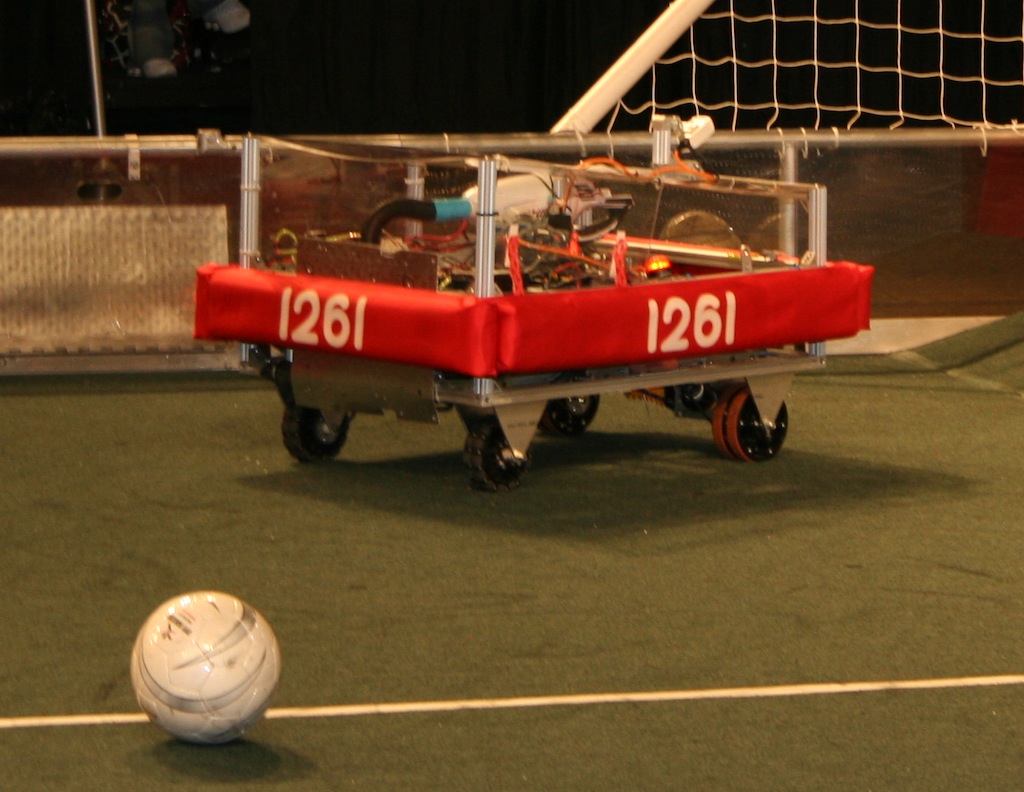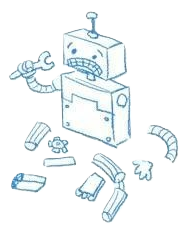Log in if you already have an account. If you would like to become an editor for the wiki, request an account.
Difference between revisions of "Chimichanga"
(Change name to Chimichanga.) |
(→Mechanics: Add lots of mechanics stuff.) |
||
| Line 9: | Line 9: | ||
==Mechanics== | ==Mechanics== | ||
| − | ===Kicker=== | + | ===Kicking System=== |
| + | The kicking system consisted of the 80/20 kicker, the winch, and the sail clutch. Each performed a role in making sure the robot successively executed a kick. | ||
| + | |||
| + | ====Kicker==== | ||
| + | The actual kicking part of the kicking system was basically a square frame of 80/20 with a attachment so that it looks like the shape of a "L" from the side. In terms of how it was mounted, the kicker was mounted so that the lower part of the "L" shape was the highest point. This point was also where the surgical tubing was attached. | ||
| + | |||
| + | At the bottom of the kicker (the top part of the "L", continuing the metaphor) was a toe to kick the ball. The toe design has changed many times over the build season, though the final design at the [[Palmetto Regional]] was using several 80/20 triangular brackets.{{citation needed}} Along with the toes, at the bottom of the kicker was also the attachment point for the winch rope. | ||
| + | |||
| + | ====Winch==== | ||
| + | The winch mechanism consisted of a Frischer Price motor that was attached to a AndyMark Super Shifter with an encoder. Early in the build season it was thought that the shifter might be needed to let the kicker actually kick, but the tension proved to be too much for the small pneumatic piston supposed to shift in/out of gear. The output shaft of the shifter consisted of a circular plate to keep wound rope on the spool. | ||
| + | |||
| + | ====Sail Clutch==== | ||
| + | The sail clutch was positioned in between the kicker and the winch. The purpose of the clutch was to allow rope to slide in both directions in one mode, but only allow it to slide in one direction in another mode. This allowed the kicker to stay in position easily until the desired time to kick came. | ||
| + | |||
| + | The clutch was operated by one small diameter pneumatic piston mounted to the back of the frame. | ||
| + | |||
===Ball Holder=== | ===Ball Holder=== | ||
| + | The ball holder's design was changed throughout the build season and even after the first competition ([[Peachtree Regional]]). | ||
| + | |||
| + | Before the [[Peachtree Regional]], the ball holder consisted of one Makita vacuum cleaner driven by a Fischer Price motor. The vacuum was connected to two AndyMark suction cups positioned in the front of the robot to grasp the ball.{{citation needed}} However, the design proved to be hard to get a good seal on the ball thus losing controllability, and also the kicker would interfere with the positioning of the two suction cups. | ||
| + | |||
| + | After the [[Peachtree Regional]] and during the [[Palmetto Regional]], work was done to convert the suction system into a roller system that was pursued early in the build season, but conclusions came that the design would not work. Work by [[Sunny Gupta]] and [[Logan Su]] on the roller pinching system made the roller system what it was during the Palmetto Regional. The roller system consisted of one roll of unobtainium powered by a Window Motor.{{citation needed}} The soccer ball was pinched by a bottom bar positioned beneath the roller along the bottom of the robot. The bottom bar was a quarter piece of 80/20 coated in a plastic material for hand tools. | ||
==Control== | ==Control== | ||
Revision as of 20:34, 28 March 2010
| This article or section is a stub. This means it lacks key information or is not complete yet. You can help by adding to it. Click here to see some more stubs to work on. |
The Chimichanga was mainly designed by Tanner Smith and Sunny Gupta. Officially (as TIMS saw it), the robot was still named "Logan Rover" from 2009, though it was named the "Chimichanga" at the 2010 Palmetto Regional.

- Year Built In: 2010
- Competition Built For: FIRST Robotics Competition
Mechanics
Kicking System
The kicking system consisted of the 80/20 kicker, the winch, and the sail clutch. Each performed a role in making sure the robot successively executed a kick.
Kicker
The actual kicking part of the kicking system was basically a square frame of 80/20 with a attachment so that it looks like the shape of a "L" from the side. In terms of how it was mounted, the kicker was mounted so that the lower part of the "L" shape was the highest point. This point was also where the surgical tubing was attached.
At the bottom of the kicker (the top part of the "L", continuing the metaphor) was a toe to kick the ball. The toe design has changed many times over the build season, though the final design at the Palmetto Regional was using several 80/20 triangular brackets.[Citation Needed] Along with the toes, at the bottom of the kicker was also the attachment point for the winch rope.
Winch
The winch mechanism consisted of a Frischer Price motor that was attached to a AndyMark Super Shifter with an encoder. Early in the build season it was thought that the shifter might be needed to let the kicker actually kick, but the tension proved to be too much for the small pneumatic piston supposed to shift in/out of gear. The output shaft of the shifter consisted of a circular plate to keep wound rope on the spool.
Sail Clutch
The sail clutch was positioned in between the kicker and the winch. The purpose of the clutch was to allow rope to slide in both directions in one mode, but only allow it to slide in one direction in another mode. This allowed the kicker to stay in position easily until the desired time to kick came.
The clutch was operated by one small diameter pneumatic piston mounted to the back of the frame.
Ball Holder
The ball holder's design was changed throughout the build season and even after the first competition (Peachtree Regional).
Before the Peachtree Regional, the ball holder consisted of one Makita vacuum cleaner driven by a Fischer Price motor. The vacuum was connected to two AndyMark suction cups positioned in the front of the robot to grasp the ball.[Citation Needed] However, the design proved to be hard to get a good seal on the ball thus losing controllability, and also the kicker would interfere with the positioning of the two suction cups.
After the Peachtree Regional and during the Palmetto Regional, work was done to convert the suction system into a roller system that was pursued early in the build season, but conclusions came that the design would not work. Work by Sunny Gupta and Logan Su on the roller pinching system made the roller system what it was during the Palmetto Regional. The roller system consisted of one roll of unobtainium powered by a Window Motor.[Citation Needed] The soccer ball was pinched by a bottom bar positioned beneath the roller along the bottom of the robot. The bottom bar was a quarter piece of 80/20 coated in a plastic material for hand tools.
Control
The robot was controlled using two XBox 360 controllers - one for driving and one for manipulation.
Driving
Driving was in a arcade like mode using two independent joysticks on the XBox 360 controller. One was used for Y speed and one was used for rotational speed.
Manipulation
Manipulation control using the XBox 360 controllers was quite simple and probably could've been accomplished using a regular joystick. One button was used for arming/firing and another as a failsafe in case the kicker refused to arm. Power setting for the kicker was set as either one of the trigger potentiometers on the controller.
Programming
The Tanner Chassis was programmed using LabVIEW. The arming and variable kick setting of the kicker was all automated using encoder values and a limit switch. The rest of the robot was pretty basic.
